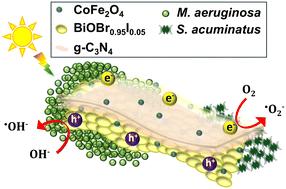当前位置:
X-MOL 学术
›
Environ. Sci.: Nano
›
论文详情
Our official English website, www.x-mol.net, welcomes your
feedback! (Note: you will need to create a separate account there.)
Combating eukaryotic and prokaryotic harmful algal blooms with visible-light driven BiOBrxI1−x/MFe2O4/g-C3N4 (M = Co & Ni) recyclable photocatalysts
Environmental Science: Nano ( IF 5.8 ) Pub Date : 2024-11-06 , DOI: 10.1039/d4en00955j Anjitha A, Shijina K, Ajayan K. V., Sindhu Swaminathan, Irene M. C. Lo, Kishore Sridharan
Environmental Science: Nano ( IF 5.8 ) Pub Date : 2024-11-06 , DOI: 10.1039/d4en00955j Anjitha A, Shijina K, Ajayan K. V., Sindhu Swaminathan, Irene M. C. Lo, Kishore Sridharan

|
Photocatalysis offers a promising avenue for completely eliminating harmful algal blooms (HABs), a significant threat to global freshwater reserves. In this study, a series of BiOBrxI1−x photocatalysts were synthesized and the most optimal catalyst was integrated with pristine g-C3N4 and pre-synthesized CoFe2O4/g-C3N4 and NiFe2O4/g-C3N4 to form binary and ternary composite heterojunction photocatalysts (BiOBr0.95I0.05/g-C3N4 – BG, CoFe2O4/BiOBr0.95I0.05/g-C3N4 – CBG, and NiFe2O4/BiOBr0.95I0.05/g-C3N4 – NBG). The synthesized photocatalysts were thoroughly characterized and their performance was evaluated through the visible light driven photocatalytic degradation of both Microcystis aeruginosa (prokaryotic) and Scenedesmus acuminatus (eukaryotic) algal cells sourced directly from ponds. The exceptional photocatalytic efficiency of CBG evidenced through the variation in chlorophyll-a content, malondialdehyde, and electrolytic leakage confirmed the complete rupture of the algal cells after 3 h of light exposure. This was further reconfirmed through fluorescence microscopy analysis and interestingly, both HABs failed to re-grow even after 10 days. The enhanced performance of CBG was attributed to the boosted generation of charge carriers facilitated by its extended visible light absorption, which in turn produced reactive oxygen species (˙O2− and ˙OH radicals) that caused irreparable oxidative damage to algal cells, while effectively suppressing the exciton pair recombination supported by its double Z-scheme heterojunction. Furthermore, the magnetic recyclability feature of CBG facilitated its easy removal from treated water for avoiding secondary pollution. The design of magnetically recyclable photocatalysts for degrading both prokaryotic and eukaryotic HABs demonstrated here is anticipated to inspire the development of efficient photocatalysts and design of cost-effective solutions required for treating ponds and lakes infected with HABs.
中文翻译:

使用可见光驱动的BiOBrxI1−x/MFe2O4/g-C3N4 (M = Co & Ni) 可回收光催化剂对抗真核和原核有害藻类的繁殖
光催化为完全消除有害藻华 (HAB) 提供了一条有前途的途径,有害藻华是对全球淡水储备的重大威胁。在本研究中,合成了一系列 BiOBrxI1−x 光催化剂,并将最优化的催化剂与原始的 g-C3N4 和预合成的 CoFe2O4/g-C3N4 和 NiFe2O4/g-C3N4 集成形成二元和三元复合异质结光催化剂(BiOBr0.95I0.05/g-C3N4 – BG、CoFe2O4/BiOBr0.95I0.05/g-C3N4 – CBG,以及 NiFe2O4/BiOBr0.95I0.05/g-c3N4 – NBG)。对合成的光催化剂进行了彻底表征,并通过可见光驱动的光催化降解直接来自池塘的铜绿微囊藻(原核生物)和 Scenedesmus acuminatus(真核生物)藻类细胞来评估其性能。通过叶绿素-a 含量、丙二醛和电解泄漏的变化证明了 CBG 卓越的光催化效率,证实了藻类细胞在光照 3 小时后完全破裂。 通过荧光显微镜分析进一步证实了这一点,有趣的是,即使在 10 天后,两种 HAB 都未能重新生长。CBG 性能的增强归因于其延长的可见光吸收促进了电荷载流子的产生,这反过来又产生了活性氧(̇O2− 和 ̇OH 自由基),对藻类细胞造成无法修复的氧化损伤,同时有效抑制了其双 Z 型异质结支持的激子对复合。此外,CBG 的磁性可回收性使其易于从处理水中去除,以避免二次污染。这里展示的用于降解原核和真核 HAB 的磁性可回收光催化剂的设计预计将激发高效光催化剂的开发和处理感染 HAB 的池塘和湖泊所需的具有成本效益的解决方案的设计。
更新日期:2024-11-06
中文翻译:

使用可见光驱动的BiOBrxI1−x/MFe2O4/g-C3N4 (M = Co & Ni) 可回收光催化剂对抗真核和原核有害藻类的繁殖
光催化为完全消除有害藻华 (HAB) 提供了一条有前途的途径,有害藻华是对全球淡水储备的重大威胁。在本研究中,合成了一系列 BiOBrxI1−x 光催化剂,并将最优化的催化剂与原始的 g-C3N4 和预合成的 CoFe2O4/g-C3N4 和 NiFe2O4/g-C3N4 集成形成二元和三元复合异质结光催化剂(BiOBr0.95I0.05/g-C3N4 – BG、CoFe2O4/BiOBr0.95I0.05/g-C3N4 – CBG,以及 NiFe2O4/BiOBr0.95I0.05/g-c3N4 – NBG)。对合成的光催化剂进行了彻底表征,并通过可见光驱动的光催化降解直接来自池塘的铜绿微囊藻(原核生物)和 Scenedesmus acuminatus(真核生物)藻类细胞来评估其性能。通过叶绿素-a 含量、丙二醛和电解泄漏的变化证明了 CBG 卓越的光催化效率,证实了藻类细胞在光照 3 小时后完全破裂。 通过荧光显微镜分析进一步证实了这一点,有趣的是,即使在 10 天后,两种 HAB 都未能重新生长。CBG 性能的增强归因于其延长的可见光吸收促进了电荷载流子的产生,这反过来又产生了活性氧(̇O2− 和 ̇OH 自由基),对藻类细胞造成无法修复的氧化损伤,同时有效抑制了其双 Z 型异质结支持的激子对复合。此外,CBG 的磁性可回收性使其易于从处理水中去除,以避免二次污染。这里展示的用于降解原核和真核 HAB 的磁性可回收光催化剂的设计预计将激发高效光催化剂的开发和处理感染 HAB 的池塘和湖泊所需的具有成本效益的解决方案的设计。






























 京公网安备 11010802027423号
京公网安备 11010802027423号